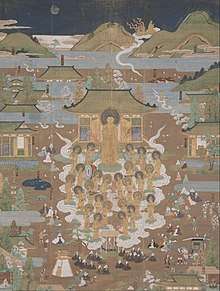Sukhavati
Sukhāvatī, or the Western Paradise, refers to the western pure land of Amitābha in Mahayana Buddhism. The Sanskrit sukhavatī (sukhāvatī) is the feminine form of sukhāvat ("full of joy; blissful"),[1][2] from sukha ("delight, joy") and -vat ("full of").[3]

| Part of a series on |
| Mahāyāna Buddhism |
|---|
 |
|
Transmission |
|
Teachings
|
|
Mahāyāna sūtras |
In other languages
There are a number of translations for Sukhāvatī. The Tibetan name is Dewachen (བདེ་བ་ཅན་, Wylie: bde ba can , "Blissful [Land]"). In Chinese, it is called Jílè (極樂, "Ultimate Bliss"), Ānlè (安樂, "Peaceful Bliss"), or Xītiān (西天, "Western Heaven"). In Japanese, it is pronounced Gokuraku (極楽, "Ultimate Bliss") or Anraku (安楽, "Peaceful Bliss"). In Korean, it is called the "Western Pure Land of Ultimate Bliss" (Korean: 서방극락정토; Hanja: 西方極楽浄土; RR: Seobang Geungnak Jeongto) or simply Jeongto "Pure Land" (Korean: 정토; Hanja: 浄土). In Vietnamese, it is called Cực lạc (Hán Nôm: 極樂 "Ultimate Bliss") or Tây Phương Tịnh Độ (西方浄土 "Western Pure Land").
Nine levels of birth
In the final part of the Amitāyurdhyāna Sūtra, Gautama Buddha discusses the nine levels into which those born into the pure land are categorized.[4]
Buddhist funerals
In Tibetan Buddhism, the world of Sukhavati is invoked during Buddhist funerals as a favorable destination for the deceased.[4] Such rituals are often accompanied with the tantric technique of phowa ("transference of consciousness") to the pure land of Amitābha, performed by a lama on the behalf of the departed. Halkias (2013:148) explains that "Sukhavati features in funeral rites and scriptures dedicated to the ritual care of the dead ('das-mchod). The structure and performance of Tibetan death ceremonies varies according to a set sequence of events...For the duration of these rites, the consciousness of the dead is coaxed into increasing levels of clarity until the time for the ritual transference to Sukhavati."
Raigō (来迎, "welcoming approach") in Japanese Buddhism is the appearance of the Amida on a "purple" cloud (紫雲) at the time of one's death.[5] The most popular belief is that the soul would then depart to the Western Paradise. A number of hanging scroll paintings depict the western paradise.
Namesakes
A number of temples are named after Sukhāvatī:
- Kek Lok Si, Malaysia
- Kek Look Seah, Malaysia
- Jile Temple, Harbin, China
- Shinshōgokuraku-ji, Kyoto, Japan
See also
- Sukhāvatīvyūha, two sūtras
References
- "sukhavati". Merriam-Webster.
Sanskrit sukhavatī, sukhāvatī, from feminine of sukhavat, sukhāvat blissful, from sukha bliss, happiness, from su good, well + kha cavity, axle hole, from khanati he digs.
- Monier-Williams Sanskrit-English Dictionary. 1899.
sukhavatī, f. N. of the heaven of Buddha Amitābha (see under sukhā-vat [...] possessing ease or comfort, full of joy or pleasure
- "vat". Dictionary for Spoken Sanskrit.
- Ceremony of Sukhavati
- "Raigō". HighBeam Research, Inc. Retrieved 16 January 2013.
Further reading
- Inagaki, Hisao, trans. (2003), The Three Pure Land Sutras (PDF), Berkeley: Numata Center for Buddhist Translation and Research, ISBN 1-886439-18-4, archived from the original on May 12, 2014CS1 maint: unfit url (link)
- Tanaka, Kenneth K. (1987). Where is the Pure Land?: Controversy in Chinese Buddhism on the Nature of Pure Land, Pacific World Journal (New Series) 3, 36-45
- Halkias, Georgios (2013). Luminous Bliss: a Religious History of Pure Land Literature in Tibet. With an Annotated Translation and Critical Analysis of the Orgyen-ling golden short Sukhāvatīvyūha-sūtra. University of Hawai‘i Press.
External links
- The Shorter Sukhāvatīvyūha Sūtra, the Amitabha Sutra
- Dol-po-pa’s: A Prayer for Birth in Sukhāvatī